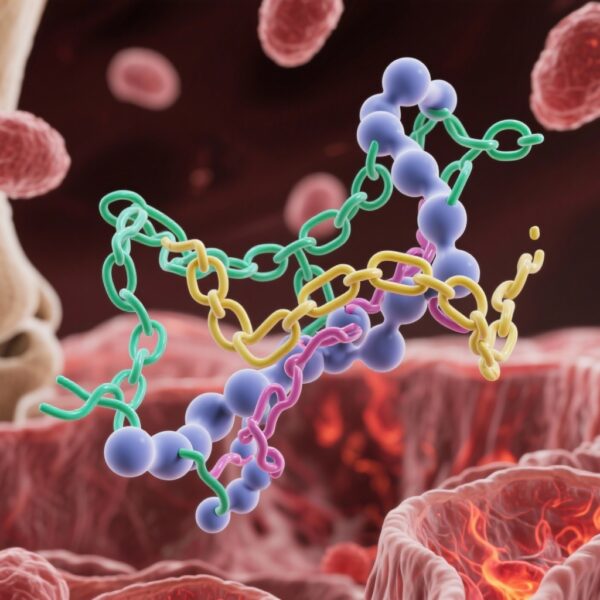Highlight
VEXAS syndrome is an autoinflammatory condition caused by somatic mutations in the UBA1 gene, primarily affecting erythroid precursors and resulting in a unique form of macrocytic anemia characterized as mosaic erythroblastopenia. Mature red blood cells in these patients do not show ubiquitylation defects, indicating the mutation’s impact is restricted to early erythroid stages. In vitro base editing of UBA1 mutations in hematopoietic progenitors shows selective vulnerability of erythroid over monocytic differentiation, with a TP53-mediated stress response reminiscent of ribosomal disorders such as Diamond-Blackfan anemia.
Study Background
VEXAS syndrome (vacuoles, E1 enzyme, X-linked, autoinflammatory, somatic) is a recently identified adult-onset autoinflammatory disorder associated with somatic mutations in the X-linked UBA1 gene. This gene encodes an ubiquitin-activating enzyme crucial for cellular protein homeostasis via ubiquitylation. Clinically, VEXAS presents with systemic inflammation, hematologic abnormalities, and frequently a macrocytic anemia that remains incompletely understood concerning its precise hematopoietic defect. Understanding the cellular pathology underlying anemia in VEXAS is essential because it contributes significantly to morbidity and mortality and could guide targeted treatments beyond immunosuppression.
Study Design
The study combined in vivo and in vitro approaches to dissect the erythroid abnormalities in VEXAS patients. In vivo assessments included analysis of bone marrow erythroblasts and mature red blood cells from patients diagnosed with VEXAS syndrome harboring UBA1 mutations. The investigators performed genetic, cytological, and functional assays to determine the distribution of UBA1 mutations across erythroid maturation stages and their impact on ubiquitylation. Complementarily, they employed CRISPR-Cas9 base-editing tools to introduce VEXAS-associated UBA1 variants into CD34+ hematopoietic progenitor cells derived from healthy donors. These modified progenitors were differentiated in vitro towards erythroid and monocytic lineages to evaluate lineage-specific effects on survival, differentiation, and molecular stress responses.
Key Findings
The study revealed that mature red blood cells from patients with VEXAS syndrome did not exhibit detectable ubiquitylation defects, suggesting that mutant UBA1 protein function impairment is not evident in circulating erythrocytes. Genetic analysis showed that bone marrow erythroblasts carrying UBA1 mutations were restricted to early erythroid precursors, specifically disappearing beyond the basophilic stage of erythroid differentiation. This points to a selective loss or negative selection of mutant clones during later erythroid maturation.
In vitro, progenitors edited to express UBA1 mutant alleles demonstrated high mortality and defective maturation during early erythropoiesis, while monocytic differentiation was relatively unaffected. Mutant erythroid precursors overexpressed TP53, a key regulator of cellular stress responses, implicating activation of a p53-mediated checkpoint in response to defective ubiquitylation. Additionally, abnormalities in ribosome biogenesis were observed, a feature reminiscent of Diamond-Blackfan anemia, a congenital ribosomopathy characterized by erythroblastopenia and macrocytic anemia.
Together, these findings support a model where VEXAS-associated anemia results primarily from a mosaic pattern of erythroblastopenia driven by UBA1 mutant clones that fail to mature properly due to ubiquitylation defects and consequent cellular stress, whereas residual wild-type UBA1 hematopoiesis partially compensates. Disease severity and anemia intensity thus depend on the balance between mutant and wild-type erythroid progenitors.
Expert Commentary
This comprehensive study delineates the hematopoietic basis of VEXAS anemia, shifting the conceptual framework from a simple macrocytic anemia to a complex mosaic erythroblastopenia with parallels to ribosomopathies. By showing that ubiquitylation defects are confined to early erythroid precursors and do not extend into mature red cells, the research clarifies why circulating erythrocytes appear functionally intact despite severe anemia. The demonstration of TP53 activation and ribosome biogenesis disruption draws attention to novel intracellular pathways that might be targeted therapeutically.
There remain questions regarding the interplay between somatic mutation burden, inflammatory milieu, and compensatory hematopoiesis influencing clinical variability. Further studies assessing longitudinal mutation dynamics and response to therapies that modulate p53 pathways or ribosome function might open new therapeutic avenues. Additionally, while the in vitro model is highly informative, in vivo confirmation and exploration of microenvironmental factors remain necessary to fully map disease complexity.
Conclusion
VEXAS syndrome-associated anemia is characterized as a mosaic erythroblastopenia stemming from selective UBA1 mutations in early erythroid progenitors that induce ubiquitylation defects, TP53-driven stress, and disrupted ribosome biogenesis. This mechanistic insight enhances understanding of the disease pathophysiology and identifies potential molecular targets for therapies aimed at improving erythropoiesis and clinical outcomes in affected patients.
Funding and ClinicalTrials.gov
The reference study was supported by institutional and national research grants as detailed in Rodrigues et al., 2025. No clinical trials are registered currently specific to therapeutic interventions based on these mechanistic findings, highlighting an opportunity for future clinical research.
References
Rodrigues F, Hardouin G, El Hoss S, Ghoul A, Gautier EF, Dussiot M, et al. VEXAS anemia is a mosaic erythroblastopenia. Blood. 2025 Sep 19:blood.2025029081. doi:10.1182/blood.2025029081. Epub ahead of print. PMID: 40971475.
Additional relevant literature includes foundational reviews on VEXAS syndrome and erythropoiesis, and studies on Diamond-Blackfan anemia pathogenesis.



